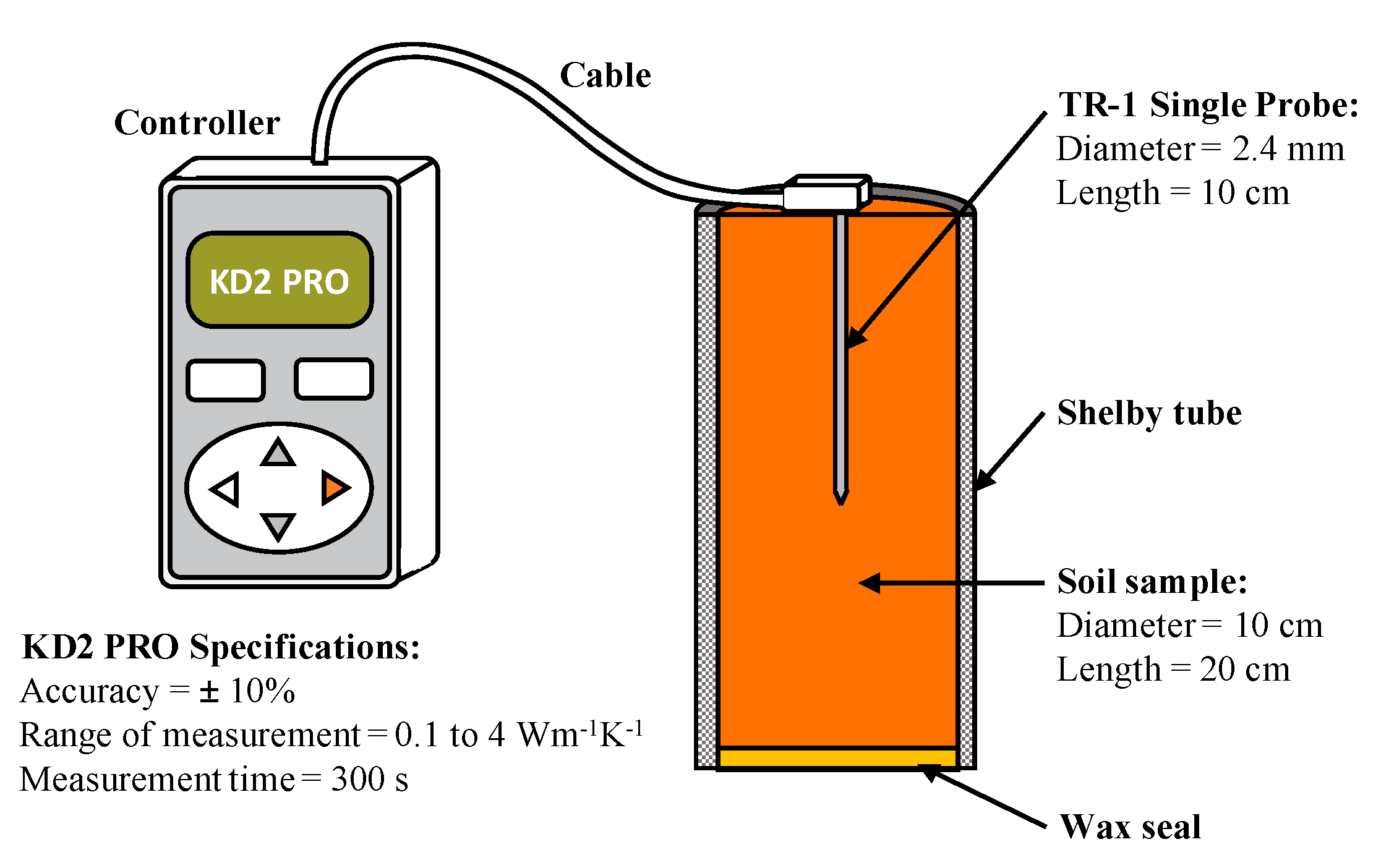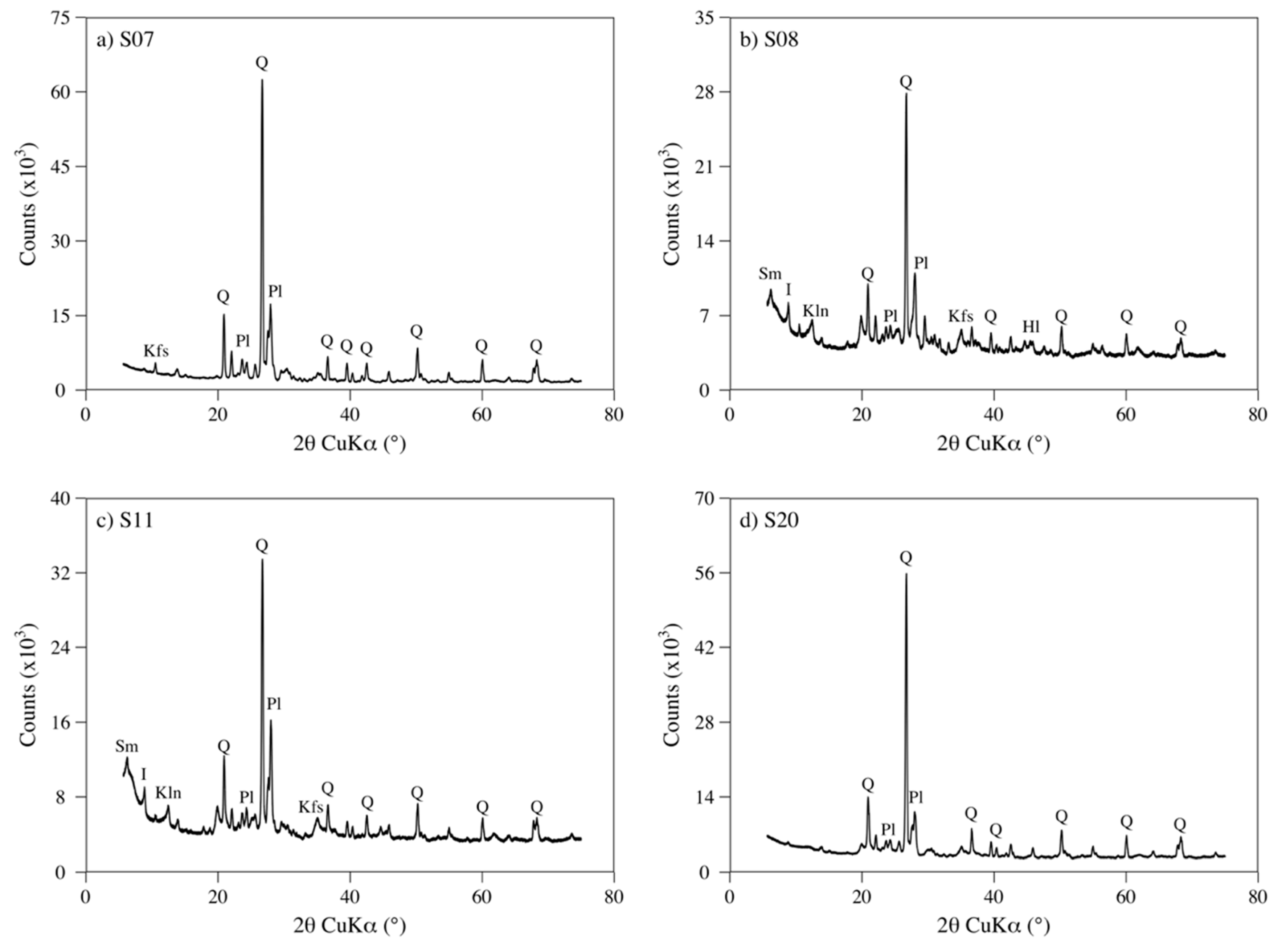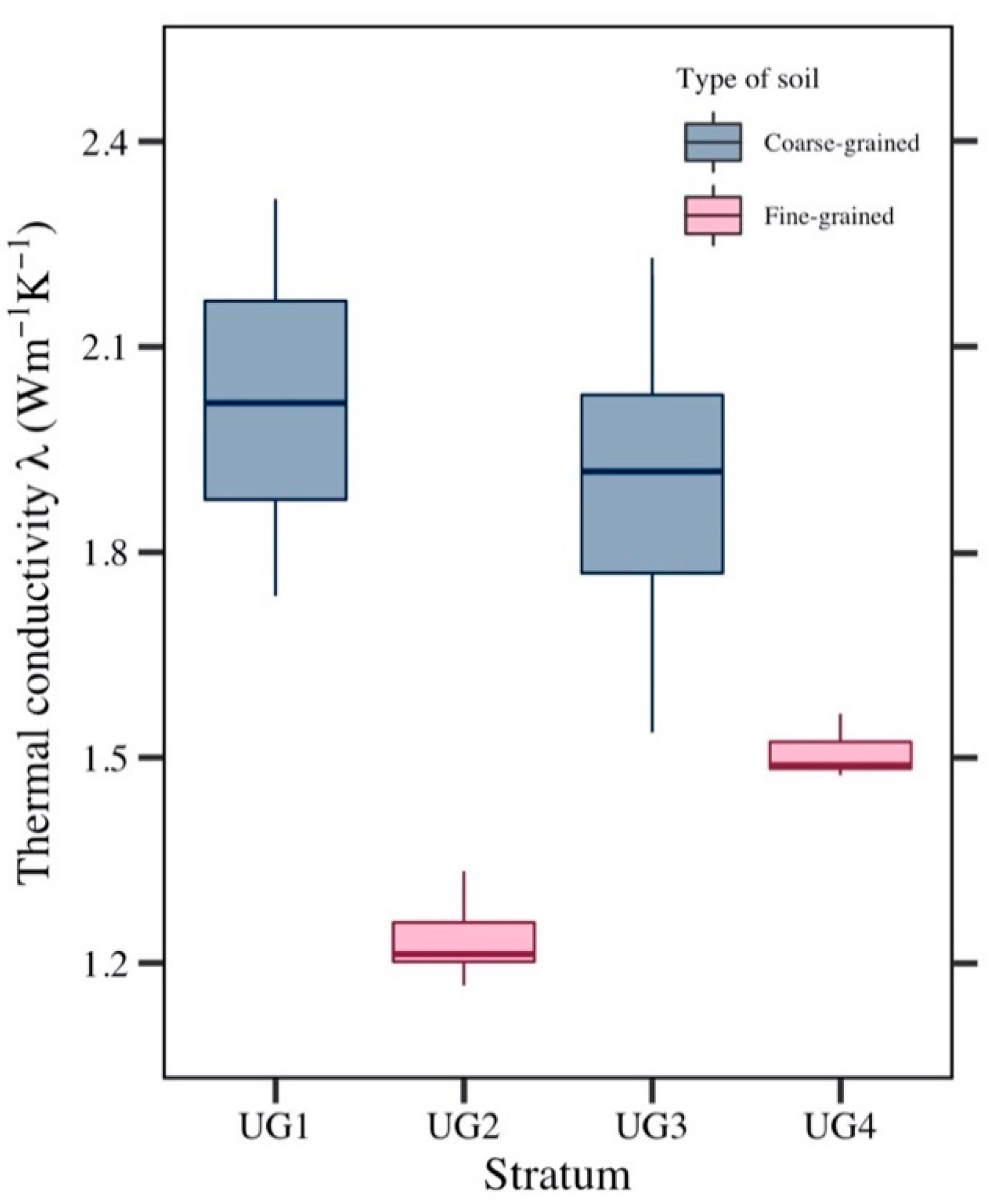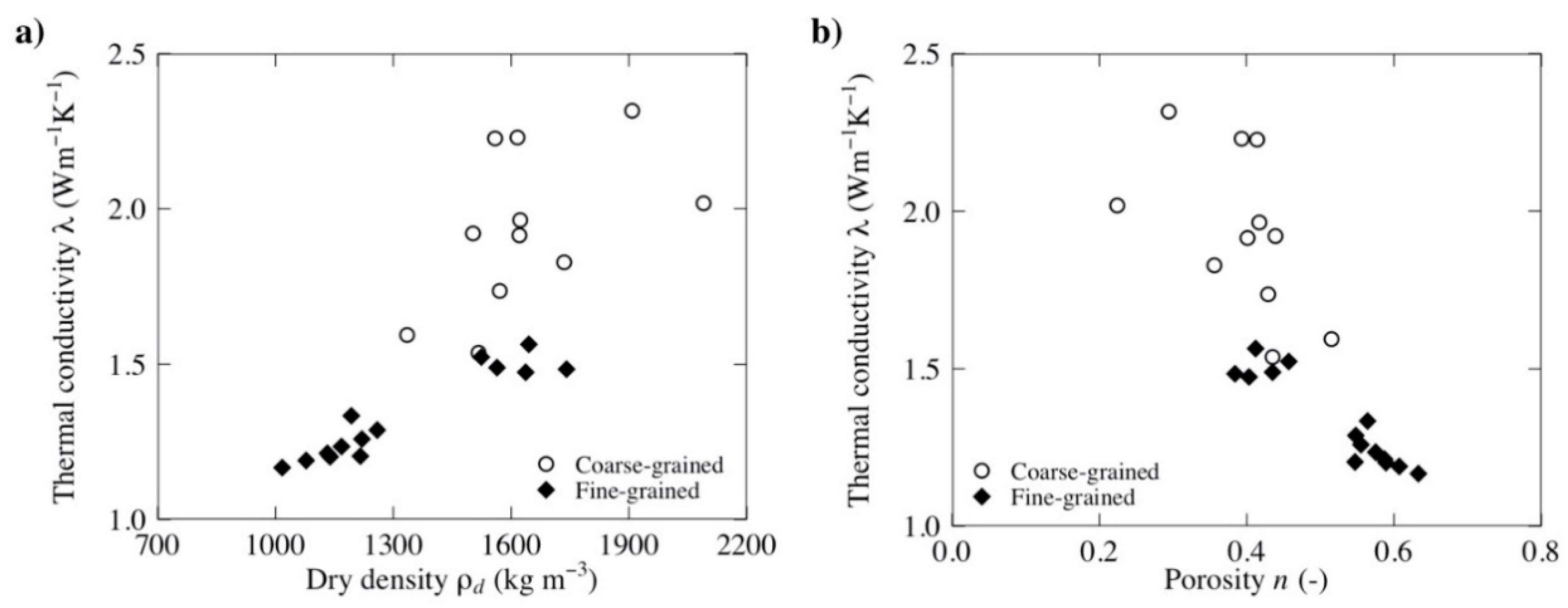Determination of Thermal Conductivity Properties of Coastal Soils for GSHPs and Energy Geostructure Applications in Mexico
Abstract
:1. Introduction
2. Materials and Methods
2.1. Site Description
2.2. Material Characterization
2.3. Thermal Properties Measurements
2.4. Evaluation of Thermal Conductivity Models and Goodness-of-Fit Metrics
3. Results and Discussion
3.1. Physical, Mineralogical, and Geotechnical Characterization of the Material
3.2. Thermal Properties Measurements
3.3. Assessment of Theoretical Thermal Conductivity Models
4. Conclusions
Author Contributions
Funding
Acknowledgments
Conflicts of Interest
References
- Secretaría de Energía (SENER). Balance Nacional de Energía 2017; Secretaría de Energía (SENER): Mexico City, Mexico, 2018. [Google Scholar]
- Oropeza-Perez, I.; Petzold-Rodriguez, A. Analysis of the energy use in the mexican residential sector by using two approaches regarding the behavior of the occupants. Appl. Sci. 2018, 8, 2136. [Google Scholar] [CrossRef] [Green Version]
- SENER. Electricity Sector Outlook 2016–2030; SENER: Mexico City, Mexico, 2016. [Google Scholar]
- López-Acosta, N.P.; Barba-Galdámez, D.F.; Sánchez, M. Numerical analysis of the thermo-mechanical behavior of an energy pile in Mexico. In Proceedings of the Energy Geotechnics SEG 2018, Lausanne, Switzerland, 25–28 September 2018; Ferrari, A., Laloui, L., Eds.; Springer: Cham, Switzerland, 2019; pp. 147–154. [Google Scholar]
- Loveridge, F.; Low, J.; Powrie, W. Site investigation for energy geostructures. Q. J. Eng. Geol. Hydrogeol. 2017, 50, 158–168. [Google Scholar] [CrossRef]
- Portillo-Arreguín, D.M.; López-Acosta, N.P.; Barba-Galdámez, D.F.; Rao Singh, M. Thermal Properties of Mexico Basin Soils. In Proceedings of the Geotechnical Engineering in the XXI Century: Lessons Learned and Future Challenges, Cancun, Mexico, 17–20 November 2019; López-Acosta, N.P., Martínez-Hernández, E., Espinosa-Santiago, A.L., Mendoza-Promotor, J.A., Ossa López, A., Eds.; IOS Press: Amsterdam, The Neherlands, 2019; pp. 2858–2863. [Google Scholar]
- Silva-Aguilar, O.F.; Andaverde-Arredondo, J.A.; Escobedo-Trujillo, B.A.; Benitez-Fundora, A.J. Determining the in situ apparent thermal diffusivity of a sandy soil. Rev. Bras. Ciência Solo 2018, 42, 1–13. [Google Scholar] [CrossRef] [Green Version]
- Farouki, O.T. Thermal Properties of Soils (No. CRREL-MONO-81-1); Cold Regions Research and Engineering Laboratory: Hanover, NH, USA, 1981. [Google Scholar]
- Barry-Macaulay, D.; Bouazza, A.; Singh, R.M.; Wang, B.; Ranjith, P.G. Thermal conductivity of soils and rocks from the Melbourne (Australia) region. Eng. Geol. 2013, 164, 131–138. [Google Scholar] [CrossRef] [Green Version]
- Eklöf, C.; Gehlin, S. TED—A Mobile Equipment for Thermal Response Test: Testing and Evaluation; Luleå University of Technology: Luleå, Sweden, 1996. [Google Scholar]
- Clarke, B.G.; Agab, A.; Nicholson, D. Model specification to determine thermal conductivity of soils. Proc. Inst. Civ. Eng. Geotech. Eng. 2008, 161, 161–168. [Google Scholar] [CrossRef]
- ASTM D5334-14. Standard Test Method for Determination of Thermal Conductivity of Soil and Soft Rock by Thermal Needle Probe Procedure; ASTM International: West Conshohocken, PA, USA, 2014. [Google Scholar]
- Gustafsson, S.E. Transient plane source techniques for thermal conductivity and thermal diffusivity measurements of solid materials. Rev. Sci. Instrum. 1991, 62, 797–804. [Google Scholar] [CrossRef]
- Jensen-Page, L.; Loveridge, F.; Narsilio, G.A. Thermal response testing of large diameter energy piles. Energies 2019, 12, 2700. [Google Scholar] [CrossRef] [Green Version]
- Low, J.E.; Loveridge, F.A.; Powrie, W.; Nicholson, D. A comparison of laboratory and in situ methods to determine soil thermal conductivity for energy foundations and other ground heat exchanger applications. Acta Geotech. 2015, 10, 209–218. [Google Scholar] [CrossRef]
- Vieira, A.; Alberdi-Pagola, M.; Christodoulides, P.; Javed, S.; Loveridge, F.; Nguyen, F.; Cecinato, F.; Maranha, J.; Florides, G.; Prodan, I.; et al. Characterisation of ground thermal and thermo-mechanical behaviour for shallow geothermal energy applications. Energies 2017, 10, 2044. [Google Scholar] [CrossRef] [Green Version]
- Soldo, V.; Borović, S.; Lepoša, L.; Boban, L. Comparison of different methods for ground thermal properties determination in a clastic sedimentary environment. Geothermics 2016, 61, 1–11. [Google Scholar] [CrossRef]
- Zhang, Y.; Gao, P.; Yu, Z.; Fang, J.; Li, C. Characteristics of ground thermal properties in Harbin, China. Energy Build. 2014, 69, 251–259. [Google Scholar] [CrossRef]
- Loveridge, F.; McCartney, J.S.; Narsilio, G.A.; Sanchez, M. Energy geostructures: A review of analysis approaches, in situ testing and model scale experiments. Geomech. Energy Environ. 2020, 22, 100173. [Google Scholar] [CrossRef] [Green Version]
- Shim, B.O.; Park, C.H. Ground thermal conductivity for (ground source heat pumps) GSHPs in Korea. Energy 2013, 56, 167–174. [Google Scholar] [CrossRef]
- Mikhaylova, O.; Johnston, I.W.; Narsilio, G.A. Uncertainties in the design of ground heat exchangers. Environ. Geotech. 2016, 3, 253–264. [Google Scholar] [CrossRef]
- Rees, S.W.; Adjali, M.H.; Zhou, Z.; Davies, M.; Thomas, H.R. Ground heat transfer effects on the thermal performance of earth-contact structures. Renew. Sustain. Energy Rev. 2000, 4, 213–265. [Google Scholar] [CrossRef]
- Dong, Y.; McCartney, J.S.; Lu, N. Critical review of thermal conductivity models for unsaturated soils. Geotech. Geol. Eng. 2015, 33, 207–221. [Google Scholar] [CrossRef]
- Aguilera-Martínez, M.A.; Zárate-López, J.; Barrios-Rodríguez, F.; Jiménez-Hernández, A. Carta Geológico-Minera Frontera E15-5. Tabasco y Campeche. Escala 1:250,000; Servicio Geológico Mexicano: Pachuca, Mexico, 2004. [Google Scholar]
- Zaragoza-Cardiel, A.I. Determinación Experimental de las Propiedades Térmicas e Hidráulicas del Suelo de Paraíso, Tabasco. Bachelor’s Thesis, Universidad Nacional Autónoma de México, Mexico City, Mexico, 2020. [Google Scholar]
- ASTM D2487-17. Standard Practice for Classification of Soils for Engineering Purposes (Unified Soil Classification System); ASTM International: West Conshohocken, PA, USA, 2017. [Google Scholar]
- IEEE Std 442-2017. Guide for Thermal Resistivity Measurements of Soils and Backfill Materials; IEEE Standards Association: New York, NY, USA, 2017. [Google Scholar]
- Carslaw, H.S.; Jaeger, J.C. Conduction of Heat in Solids, 2nd ed.; Oxford University Press: Oxford, UK, 1959; ISBN 0198533683. [Google Scholar]
- Jia, G.S.; Tao, Z.Y.; Meng, X.Z.; Ma, C.F.; Chai, J.C.; Jin, L.W. Review of effective thermal conductivity models of rock-soil for geothermal energy applications. Geothermics 2019, 77, 1–11. [Google Scholar] [CrossRef]
- Johansen, O. Thermal Conductivity of Soils (Draft Translation 637); Cold Regions Research and Engineering Laboratory: Hanover, NH, USA, 1977. [Google Scholar]
- Barry-Macaulay, D.; Bouazza, A.; Wang, B.; Singh, R.M. Evaluation of soil thermal conductivity models. Can. Geotech. J. 2015, 52, 1892–1900. [Google Scholar] [CrossRef]
- Dai, Y.; Wei, N.; Yuan, H.; Zhang, S.; Shangguan, W.; Liu, S.; Lu, X.; Xin, Y. Evaluation of Soil Thermal Conductivity Schemes for Use in Land Surface Modeling. J. Adv. Model. Earth Syst. 2019, 11, 3454–3473. [Google Scholar] [CrossRef]
- Côté, J.; Konrad, J.M. A generalized thermal conductivity model for soils and construction materials. Can. Geotech. J. 2005, 42, 443–458. [Google Scholar] [CrossRef]
- Balland, V.; Arp, P.A. Modeling soil thermal conductivities over a wide range of conditions. J. Environ. Eng. Sci. 2005, 4, 549–558. [Google Scholar] [CrossRef]
- Kirkpatrick, S. Percolation and conduction. Rev. Mod. Phys. 1973, 45, 574–588. [Google Scholar] [CrossRef]
- Donazzi, F.; Occhini, E.; Seppi, A. Soil thermal and hydrological characteristics in designing underground cables. Proc. Inst. Electr. Eng. 1979, 126, 506–516. [Google Scholar] [CrossRef]
- Gori, F.; Corasaniti, S. Theoretical prediction of the soil thermal conductivity at moderately high temperatures. J. Heat Transf. 2002, 124, 1001–1008. [Google Scholar] [CrossRef]
- Horai, K. Thermal conductivity of rock-forming minerals. J. Geophys. Res. 1971, 76, 1278–1308. [Google Scholar] [CrossRef]
- Brigaud, F.; Vasseur, G. Mineralogy, porosity and fluid control on thermal conductivity of sedimentary rocks. Geophys. J. Int. 1989, 98, 525–542. [Google Scholar] [CrossRef] [Green Version]
- Hicher, P.Y.; Wahyudi, H.; Tessier, D. Microstructural analysis of inherent and induced anisotropy in clay. Mech. Cohesive-Frict. Mater. 2000, 5, 341–371. [Google Scholar] [CrossRef]
- Dalla Santa, G.; Galgaro, A.; Sassi, R.; Cultrera, M.; Scotton, P.; Mueller, J.; Bertermann, D.; Mendrinos, D.; Pasquali, R.; Perego, R.; et al. An updated ground thermal properties database for GSHP applications. Geothermics 2020, 85, 101758. [Google Scholar] [CrossRef]
- Welch, B.L. On the comparison of several mean values: An alternative approach. Biometrika 1951, 38, 330. [Google Scholar] [CrossRef]
- Games, P.A.; Howell, J.F. Pairwise multiple comparison procedures with unequal N’s and/or variances: A monte carlo study. J. Educ. Stat. 1976, 1, 113–125. [Google Scholar] [CrossRef]
- Midttømme, K.; Roaldset, E.; Aagaard, P. Thermal conductivities of argillaceous sediments. Geol. Soc. Lond. Eng. Geol. Spec. Publ. 1997, 12, 355–363. [Google Scholar] [CrossRef]









| Model | Equations |
|---|---|
| Johansen [30] | |
| Effective medium theory (EMT) [35] | |
| Donazzi et al. [36] | |
| Gori and Corasaniti [37] | |
| Cotê and Konrad [33] | |
| Balland and Arp [34] |
| Soil Property | Stratigraphic Unit | |||||||
|---|---|---|---|---|---|---|---|---|
| UG1 (N = 3) | UG2 (N = 9) | UG3 (N = 8) | UG4 (N = 5) | |||||
| Mean | CV (%) | Mean | CV (%) | Mean | CV (%) | Mean | CV (%) | |
| ρ | 2130 | 8.4 | 1730 | 2.7 | 1960 | 5.0 | 2087 | 6.1 |
| ρd | 1860 | 14.1 | 1160 | 6.5 | 1560 | 7.6 | 1620 | 5.1 |
| w | 13.4 | 20.9 | 50.5 | 10.1 | 23.4 | 13.2 | 26.1 | 10.3 |
| f | 24.2 | 48.1 | 95.4 | 5.3 | 26.3 | 26.0 | 77.1 | 16.6 |
| LL | 20.3 | 12.3 | 69.6 | 14,1 | 31.4 | 12.1 | 57 | 21.9 |
| PI | - | - | 41.9 | 17.4 | - | - | 33.4 | 33.5 |
| Gs | 2.713 | 1.2 | 2.747 | 1.1 | 2.709 | 1.6 | 2.764 | 0.9 |
| n | 0.316 | 32.9 | 0.578 | 5.0 | 0.421 | 10.9 | 0.418 | 6.7 |
| S | 0.918 | 5.3 | 0.988 | 0.9 | 0.915 | 5.3 | 0.992 | 1.9 |
| OM | 0.57 | 36.8 | 3.88 | 26.5 | 1.91 | 37.7 | 2.26 | 20.3 |
| Sample | Soil Strata | Borehole | Depth (m) | Identified Mineral Phases and Semi-Quantitative Analysis a,b | |||||||
|---|---|---|---|---|---|---|---|---|---|---|---|
| Act | Hl | I | Kln | Kfs | Pl | Q | Sm | ||||
| S07 | UG1 | BH-04 | 8.5 | + | − | − | + | +++ | ++++ | ++++ | |
| S08 | UG2 | BH-04 | 14.6 | − | − | − | + | ++ | ++++ | +++ | − |
| S11 | UG4 | BH-04 | 36.7 | + | − | − | + | ++ | ++++ | +++ | + |
| S20 | UG3 | BH-18 | 17.9 | − | − | − | + | ++ | ++++ | +++ | + |
| Stratigraphic Unit | N | Minimum | Maximum | m (95% CI) | s | CV (%) |
|---|---|---|---|---|---|---|
| W m−1 K−1 | ||||||
| UG1 | 3 | 1.74 | 2.32 | 2.023 (1.302–2.744) | 0.290 | 14.3 |
| UG2 | 9 | 1.17 | 1.33 | 1.232 (1.192–1.272) | 0.053 | 4.3 |
| UG3 | 8 | 1.54 | 2.23 | 1.902 (1.690–2.114) | 0.254 | 13.4 |
| UG4 | 5 | 1.47 | 1.56 | 1.507 (1.461–1.553) | 0.037 | 2.5 |
| Model | Complete Dataset | Coarse-Grained Soil | Fine-Grained Soil | |||
|---|---|---|---|---|---|---|
| R2 | RMSE | R2 | RMSE | R2 | RMSE | |
| Johansen [30] | 0.631 | 0.334 | 0.272 | 0.482 | 0.833 | 0.127 |
| EMT [35] | 0.606 | 0.239 | 0.300 | 0.241 | 0.896 | 0.175 |
| Donazzi et al. [36] | 0.577 | 0.282 | 0.250 | 0.413 | 0.887 | 0.092 |
| Gori–Corasaniti [37] | 0.592 | 0.261 | 0.229 | 0.387 | 0.890 | 0.063 |
| Cotê–Konrad [33] | 0.569 | 0.290 | 0.255 | 0.423 | 0.873 | 0.098 |
| Balland–Arp [34] | 0.599 | 0.386 | 0.306 | 0.549 | 0.840 | 0.172 |
Publisher’s Note: MDPI stays neutral with regard to jurisdictional claims in published maps and institutional affiliations. |
© 2021 by the authors. Licensee MDPI, Basel, Switzerland. This article is an open access article distributed under the terms and conditions of the Creative Commons Attribution (CC BY) license (https://creativecommons.org/licenses/by/4.0/).
Share and Cite
López-Acosta, N.P.; Zaragoza-Cardiel, A.I.; Barba-Galdámez, D.F. Determination of Thermal Conductivity Properties of Coastal Soils for GSHPs and Energy Geostructure Applications in Mexico. Energies 2021, 14, 5479. https://doi.org/10.3390/en14175479
López-Acosta NP, Zaragoza-Cardiel AI, Barba-Galdámez DF. Determination of Thermal Conductivity Properties of Coastal Soils for GSHPs and Energy Geostructure Applications in Mexico. Energies. 2021; 14(17):5479. https://doi.org/10.3390/en14175479
Chicago/Turabian StyleLópez-Acosta, Norma Patricia, Alan Igor Zaragoza-Cardiel, and David Francisco Barba-Galdámez. 2021. "Determination of Thermal Conductivity Properties of Coastal Soils for GSHPs and Energy Geostructure Applications in Mexico" Energies 14, no. 17: 5479. https://doi.org/10.3390/en14175479







